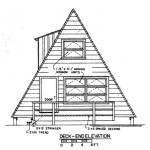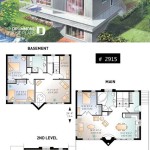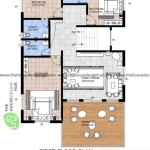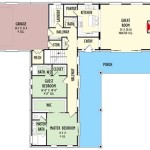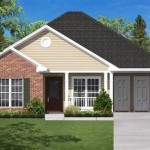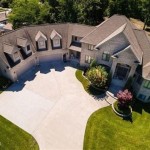Small House Plans With Lots of Windows: Maximizing Light and Space
The appeal of small house living has grown significantly in recent years, driven by factors such as affordability, sustainability, and a desire for a simpler lifestyle. However, downsizing doesn't necessitate sacrificing comfort and aesthetics. One compelling way to enhance the livability of a small home is through strategic incorporation of numerous windows. Small house plans with lots of windows leverage natural light to create an illusion of spaciousness, improve mood, and reduce energy consumption. Careful planning and execution are crucial to achieving the desired results without compromising privacy or structural integrity.
Designing small house plans with a generous allotment of windows requires a different approach than designing for larger structures. Consideration must be given to factors such as window placement to optimize solar gain, window types that maximize light transmission, and strategies to mitigate glare and heat gain during peak sunlight hours. This article will explore the key aspects of designing small house plans that prioritize abundant natural light through the incorporation of well-placed and thoughtfully selected windows.
Understanding the Benefits of Natural Light
The incorporation of ample windows in small house plans provides several demonstrable benefits beyond mere aesthetics. Natural light is vital for human health and well-being, influencing both physical and psychological states. Exposure to sunlight regulates the body's circadian rhythm, improving sleep quality and promoting alertness during the day. Furthermore, natural light stimulates the production of Vitamin D, an essential nutrient for bone health and immune function. Psychologically, natural light has been shown to reduce symptoms of Seasonal Affective Disorder (SAD) and improve overall mood.
From an economic standpoint, maximizing natural light reduces the need for artificial lighting during daylight hours, leading to lower electricity bills and a reduced carbon footprint. The strategic placement of windows can also contribute to passive solar heating in cooler climates. South-facing windows allow sunlight to enter the home during the winter months, warming the interior and reducing the reliance on heating systems. Conversely, proper shading and orientation can prevent excessive heat gain during the summer, minimizing the need for air conditioning.
The aesthetic benefits of abundant natural light are equally compelling. Natural light enhances the colors of interior furnishings and materials, creating a more vibrant and visually appealing living space. It also creates a sense of spaciousness, making a small house feel larger and more inviting. The play of light and shadow throughout the day adds depth and interest to the interior, transforming a simple space into a dynamic and engaging environment.
Strategic Window Placement and Types
The placement and type of windows are critical factors in designing small house plans with lots of windows. Careful consideration must be given to the orientation of the house, the surrounding landscape, and the desired level of privacy. A well-designed window layout should maximize solar gain in the winter, minimize heat gain in the summer, and provide ample natural light throughout the year.
South-facing windows are ideal for maximizing solar gain in cooler climates. These windows should be large and unobstructed to allow sunlight to penetrate deep into the interior of the house. Overhangs or awnings can be used to shade these windows during the summer months, preventing excessive heat gain. In warmer climates, east- and west-facing windows should be minimized, as these windows are prone to overheating during the morning and afternoon hours. North-facing windows provide consistent, diffused light throughout the day, making them suitable for areas where direct sunlight is not desired.
Different types of windows offer varying levels of light transmission, ventilation, and energy efficiency. Casement windows, which crank open outward, offer excellent ventilation and a clear view. Awning windows, which hinge at the top and open outward, can be left open during light rain without allowing water to enter the house. Picture windows provide unobstructed views and maximize light transmission, but they do not offer ventilation. Skylights are an effective way to bring natural light into interior spaces that lack exterior walls, but they require careful installation to prevent leaks and condensation. Clerestory windows, placed high on walls, provide privacy while still allowing ample natural light to enter the room.
The size of the windows also plays a crucial role in maximizing natural light. Larger windows allow more light to enter the house, but they can also increase heat gain and heat loss. The optimal window size will depend on the orientation of the house, the climate, and the desired level of energy efficiency. A qualified architect or designer can help determine the ideal window size and placement for a specific project.
Addressing Privacy and Energy Efficiency Concerns
While abundant windows offer numerous benefits, it is essential to address potential concerns related to privacy and energy efficiency. Large windows can compromise privacy, particularly in urban environments or on properties with close neighbors. Energy efficiency is also a key consideration, as windows can be a significant source of heat loss in the winter and heat gain in the summer.
Several strategies can be employed to mitigate privacy concerns. Window coverings, such as blinds, shades, and curtains, offer adjustable levels of privacy. Opaque or translucent window films can also be applied to the glass to obscure the view from the outside while still allowing light to enter the house. Landscaping can also be used to create a natural privacy screen, with trees, shrubs, and hedges strategically planted to block views from neighboring properties. Frosted glass or decorative glass patterns can be used in areas where privacy is a primary concern, such as bathrooms and bedrooms.
To improve energy efficiency, it is crucial to select windows with a low U-factor and a low solar heat gain coefficient (SHGC). The U-factor measures the rate of heat transfer through the window, with lower values indicating better insulation. The SHGC measures the fraction of solar radiation that enters the house through the window, with lower values indicating less heat gain. Double-pane or triple-pane windows with low-E coatings can significantly reduce heat loss and heat gain. Proper window installation is also essential to prevent air leaks and moisture damage. Sealing around the windows with caulk or weather stripping can further improve energy efficiency.
In addition to selecting energy-efficient windows, it is also important to consider shading strategies to minimize heat gain during the summer months. Overhangs, awnings, and trees can provide effective shading for south-facing windows. Exterior shades or blinds can be used to block sunlight before it enters the house. Interior shades or blinds can also be used, but they are less effective at preventing heat gain because the sunlight has already entered the house. Utilizing window films specifically designed to block solar heat can further reduce the load on air conditioning systems during peak summer months.
Implementing passive ventilation strategies can also leverage window placement for optimal comfort. Operable windows, strategically placed to create cross-breezes, can help cool the house naturally without relying on air conditioning. High windows or clerestory windows can be used to vent hot air that rises to the top of the room. A well-designed passive ventilation system can significantly reduce energy consumption and improve indoor air quality.
Designing with natural light also informs material choices. Lighter interior paint colors and reflective surfaces will amplify the effect of natural light, further enhancing the sense of spaciousness in a small home. Conversely, darker colors will absorb light and can make a small space feel even smaller. Flooring materials, such as light-colored wood or tile, can also contribute to a brighter and more inviting interior.
Integrating outdoor living spaces with the interior through the use of large windows and sliding glass doors can extend the usable living area and create a seamless connection with nature. Decks, patios, and porches can provide additional space for relaxation and recreation, blurring the lines between indoors and outdoors. Thoughtful landscaping can enhance the privacy and aesthetics of the outdoor living spaces, creating a tranquil and inviting environment.
Small house plans with lots of windows require a holistic design approach that considers the interplay of light, space, privacy, and energy efficiency. By carefully selecting and placing windows, implementing shading strategies, and incorporating passive ventilation techniques, it is possible to create a small home that is both comfortable and sustainable. The benefits of abundant natural light extend beyond mere aesthetics, contributing to improved health, well-being, and a reduced carbon footprint. A well-designed small house with lots of windows can be a haven of light and tranquility, offering a fulfilling and enriching living experience.
Cabin Floor Plans With Lots Of Windows Blog Eplans Com

Beach Home Plans Outdoor Living Spaces The House Designers

Cabin Floor Plans With Lots Of Windows Blog Eplans Com

House Plan Ch9 Window Design Plans Small

Small House Ch64 Plans Design Container

Home Plans With Lots Of Windows For Great Views

House Plan 1 Bedrooms Bathrooms 1709 Drummond Plans

Plan Of A Barnhouse Style Frame House With 3 Bedrooms And Large Veranda Windows

Small House Plan Ch64 Home Floor

Small House Plan Ch66 To Narrow Lot With Three Bedrooms

